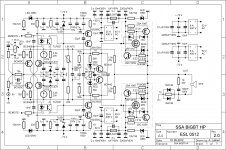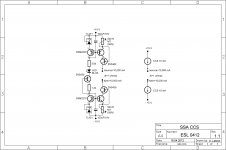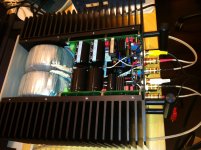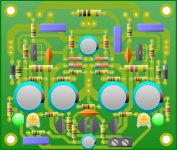Whatever the point of view from which we observe an amplifier,, slewrate is definitively the goal.
"Faster" is the amp, more you can add Feed back. Despite the wrong bad reputation of feedback, more feedback more DF, less harmonic distortion.
"Faster" the amp, less IM or TIM. better the sound.

We have a perfect example with the current source we were talking about here. It increase bandwidth SO reduce distortion. Everything is stuck together.


[L.C you are one of the rare audio designer with have a *complete* view of audio closed loops. Including the signals generated by the loudspeakers when they move, feeding the feedback returns with high level errors signals.



I'm convinced that, when the CSSA (Complete state-of-the-art symetrical amplifier ) will be tuned in the littlest detail, this forum will have his master piece.




The thing that works for me is the SSA fact that the time the signal takes to complete its journey from the base of input BJTs (then via the cascode, the VAS, the output stage and the passives/parasitics) to its emitter is only NANOSECONDS. So we can forget about bandlimiting and the ghosts that come with it. Listening test clearly justifies the idea and we have a close-to-ideal audio amplifier at hand with a stable full gain bandwidth of at least 100 times the audio range. A dream of many DIY guys is a reality now, with SUCH simple circuitry! It's just a matter of time for the whole community to go the SSA way.
Is there a PCB drawing that includes the additions that Shaan has implemented?
Hi Harry

There are some PCBs with CCS included
- TSSA post #235, schematic few posts earlier
- TSSA post #957, schematic few posts earlier
- SSA post #2871, shematic few posts earlier, without CCSs
That's something for the start. 😉
We could all make consensus on specific schematic and make GB PCB once hehe
Regards, Andrej 🙂
The thing that works for me is the SSA fact that the time the signal takes to complete its journey from the base of input BJTs (then via the cascode, the VAS, the output stage and the passives/parasitics) to its emitter is only NANOSECONDS. So we can forget about bandlimiting and the ghosts that come with it. Listening test clearly justifies the idea and we have a close-to-ideal audio amplifier at hand with a stable full gain bandwidth of at least 100 times the audio range. A dream of many DIY guys is a reality now, with SUCH simple circuitry! It's just a matter of time for the whole community to go the SSA way.
Thanks Shaan for all kind words, since you're the man of action, all the words come out from truly positive practical experiences and that's what it really counts.

I agree 100% with your last sentence, after all experiences and positive results it is time to make a PCB from SSA schematic that is tested and includes all necessary features to ensure pure SSA sound. So first we need consensus on schematic and than will make PCB, maybe even for GB.

Thanks Shaan for all kind words, since you're the man of action, all the words come out from truly positive practical experiences and that's what it really counts.
I agree 100% with your last sentence, after all experiences and positive results it is time to make a PCB from SSA schematic that is tested and includes all necessary features to ensure pure SSA sound. So first we need consensus on schematic and than will make PCB, maybe even for GB.
Yup!
LC, now that's sounding like what's up!
🙂😉😎
is the sch in post159?........................- TSSA post #235, schematic few posts earlier.............
Actually is this one, OK it is the same as mine, but with proper parts numbering as on the PCB. 😉
Is there bottom image for Toner transfer?
Is there bottom image for Toner transfer?
Please try to ask Idefixes since the PCB is his design. I'm quite sure he'll help you with toner transfer, since he did that as well as you can see here.
Please try to ask Idefixes since the PCB is his design. I'm quite sure he'll help you with toner transfer, since he did that as well as you can see here.
thanks for info Lazy
LC, so the schematic in post #2992 in this thread (SSA thread) and post # 205 in the TSSA thread are essentially the same. Just one question and sorry that I might have missed this one - but, is the 10K NTC the only heat-sensing component for output bias?
Alway repeating the same things, but FB resistance's position is the worse you can imagine on this PCB.Actually is this one,
I wish we had such nice toroids available here. 🙁
Well there is hope, as the net says, some companies have started mass production and soon the story is going to turn better... 🙂
Well there is hope, as the net says, some companies have started mass production and soon the story is going to turn better... 🙂
Thanks LC. So my reference to post #2992 is actually TSSA BIGBT HP and what you have reposted here in post #3034 is the SSA BIGBT HP. It is now clear to me and should help others as well.
Any reason for not using BF245B and 2N5486 JFETs in the SSA BIGBT HP? Just asking as I have them, as well as 2N5462. Moreoever, the voltage rating of 2N5459 is lesser than 2N5486.
Although this question belongs to the TSSA thread, is the 10K NTC the only heat sensing device in TSSA BIGBT HP?
Thanks.
Any reason for not using BF245B and 2N5486 JFETs in the SSA BIGBT HP? Just asking as I have them, as well as 2N5462. Moreoever, the voltage rating of 2N5459 is lesser than 2N5486.
Although this question belongs to the TSSA thread, is the 10K NTC the only heat sensing device in TSSA BIGBT HP?
Thanks.
I wish we had such nice toroids available here. 🙁
Well there is hope, as the net says, some companies have started mass production and soon the story is going to turn better... 🙂
Locally produced. What I like about them is that the core is welded at both ends under mechanical tension to the ribbon, than complete core goes to plastic bath to be thickly coated in hard plastic. With this procedure they minimize possible ribbon vibration noises to minimum. 😎
Last edited:
Beautiful packaging.
Thanks Andrew. Yes, I like compact, minimum volume devices, but still on the safe side regarding dissipation-temperature.

- Status
- Not open for further replies.
- Home
- Amplifiers
- Solid State
- Simple Symetrical Amplifier




